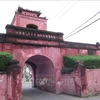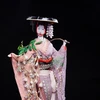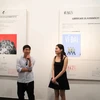The One Pillar Pagoda, a historic Buddhist temple in Hanoi, has been recognised by the Asian Records Organisation as having the most unique architecture on the continent, the Vietnam Records Organisation said on October 17.
Originally dubbed Dien Huu, which means long-lasting happiness and good luck, the pagoda was built in 1049 on the orders of King Ly Thai Tong.
During the Ly Dynasty, to mark Vesak or Buddha’s birthday, it was the site where an annual royal ceremony to celebrate the event was held.
Legend has it that Ly Thai Tong, who had no children, used to go to pagodas to pray to Buddha for a son. One night, he dreamt that he met Bodhisattva Avalokiteshvara, the Goddess of Mercy, sitting on a great lotus flower in a square-shaped pond and handed him a baby boy.
Months later, when the Queen gave birth to a boy, the King was advised by a monk to erect a pillar in the middle of a lotus pond, similar to the one he had seen in his dream, in honour of the Goddess of Mercy.
It was built of wood on a single stone pillar 1.25m in diameter, 4m high and resembled a lotus blossom, the Buddhist symbol of purity.
With all its architectural and historical values, the pagoda was classified as a national historic site in 1962. On May 4, 2006, it was recorded in Vietnam ’s Guinness Book of Records as the pagoda with the most unique architecture in Vietnam .
During its long history, the complex has undergone a number of renovations and has become one of the most interesting architectural complexes in Hanoi, attracting large numbers of domestic and overseas tourists alike.-VNA
Originally dubbed Dien Huu, which means long-lasting happiness and good luck, the pagoda was built in 1049 on the orders of King Ly Thai Tong.
During the Ly Dynasty, to mark Vesak or Buddha’s birthday, it was the site where an annual royal ceremony to celebrate the event was held.
Legend has it that Ly Thai Tong, who had no children, used to go to pagodas to pray to Buddha for a son. One night, he dreamt that he met Bodhisattva Avalokiteshvara, the Goddess of Mercy, sitting on a great lotus flower in a square-shaped pond and handed him a baby boy.
Months later, when the Queen gave birth to a boy, the King was advised by a monk to erect a pillar in the middle of a lotus pond, similar to the one he had seen in his dream, in honour of the Goddess of Mercy.
It was built of wood on a single stone pillar 1.25m in diameter, 4m high and resembled a lotus blossom, the Buddhist symbol of purity.
With all its architectural and historical values, the pagoda was classified as a national historic site in 1962. On May 4, 2006, it was recorded in Vietnam ’s Guinness Book of Records as the pagoda with the most unique architecture in Vietnam .
During its long history, the complex has undergone a number of renovations and has become one of the most interesting architectural complexes in Hanoi, attracting large numbers of domestic and overseas tourists alike.-VNA



















